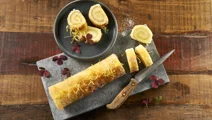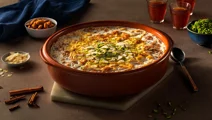Fried qatayef

One of the most popular ways to serve the Ramadan dessert qatayef is fried. Turning the tender, sweet pancakes into crispy fried half-moon-shaped cones creates a wonderful contrast between them and the fresh, velvety cream with which they are filled. The treat is, of course, served with decorative and tasty pistachios as well as a homemade sugar syrup flavoured with delicate rose water. Try our fried qatayef and qatayef dough recipe to make a homemade version of this special treat.
Ingredients
Qatayef:
|
160 g
Cream
|
|
|---|---|
|
120 g
Flour
|
|
|
1 tbsp
Yeast
|
|
|
1 tbsp
Baking powder
|
|
|
2 tbsp
Sugar
|
|
|
1 tsp
Salt
|
|
|
480 ml
Warm water
|
|
|
Vegetable oil, for frying
|
Sugar syrup:
|
2 tbsp
Blossom water
|
|
|---|---|
|
1 tsp
Lemon juice
|
|
|
240 ml
Water
|
|
|
200 g
Sugar
|
Garnish:
|
Chopped pistachios
|
|---|
Instructions
Qatayef dough:
Syrup:
For serving:
Recipe tips
It’s often the small details that make the biggest impact in the kitchen, so we’re sharing the tips we rely on when cooking and creating recipes
If you would prefer, it is also possible to make baked qatayef as opposed to frying them. After cooking and folding the pancakes into half-moon-shaped cones, rub them with ghee or clarified butter and bake them in the middle of the oven for 8-10 minutes at 230°C. The ghee or butter helps the pancakes crisp up. After they have cooled slightly, fill them with cream, and serve the golden delights as you would serve regular fried qatayef.
Questions about fried qatayef
Fried qatayef are deliciously crispy on the outside and delectably creamy on the inside. To learn more about the sweet, fried treat, keep reading below.
What is fried qatayef?
Fried qatayef, sometimes called atayef or katayef, is a special Arab, Ramadan treat that is only enjoyed during the holy month. Many believe that no iftar meal is complete without it. The dessert dish consists of small, fluffy pancakes that have been folded into a half-moon-shaped cone before being fried. The cone-shaped fried qatayef pancakes are then filled with a creamy filling, dipped in chopped pistachios for crunch and colour, and drizzled or served with a thick, rose water-flavoured sugar syrup.
How to make qatayef dough?
Making batter for baked or fried qatayef is quite easy. Simply mix flour, baking powder, sugar, yeast, and salt with warm water until well combined. To ensure a soft and fluffy pancake, the dough must be allowed to rest for at least 20 minutes and preferably 1 hour. The batter should, ideally, be quite runny. However, it should not be soup-like in its consistency.
How to fry qatayef?
To make delicious golden brown fried qatayef with a crispy exterior, your oil needs to have the correct temperature. Heat it slowly at medium heat until it reaches the desired temperature of 180-190°C. You can use a cooking thermometer to keep an eye on its temperature. Cook only a few half-moon cones at a time to not lower the temperature of the oil. If it dips too low, the fried qatayef pancakes are prone to absorb the liquid and become soggy rather than crispy. After any excess oil has run off and they have cooled slightly, you can fill them with cream, sprinkle them with pistachios, and serve them with rose-flavoured sugar syrup.
Can you freeze fried qatayef?
Yes! However, since the dairy-based cream filling is prone to splitting, it is best to freeze only the fried qatayef pancakes themselves. After shaping and frying them, let them cool, then place them on a baking tray and flash-freeze them. This will prevent them from sticking together once you transfer them to freezer-safe bags or airtight containers. In the freezer, they will last for about 3 months. Thaw them overnight in the fridge. Let them reach room temperature or warm them gently in the oven before stuffing the fried qatayef with a freshly-made cream filling.
What does fried qatayef taste like?
Unlike the classic kind, fried qatayef has a crispy exterior rather than a soft one. But what is qatayef and how is it different from fried qatayef? Both versions of the traditional Ramadan dessert have a velvety, thick cream filling that is both smooth and fresh and are served with chopped pistachios and rose water sugar syrup. As such, both taste sweet, nutty, and a bit floral. So, the biggest difference between regular and fried qatayef is the crunchy surface and the slightly different flavour that being fried in oil gives the pancake cones.
Recommended information
Serving suggestion
Homemade fried qatayef with cream filling
Something about fried desserts sets them apart from the rest and marks them as something special. When these fried qatayef are cooked in oil and gain their crispy exterior, their naturally sweet flavours are enhanced and changed to become even more delicious. When filled with thick, fresh-tasting cream, sprinkled with pistachios, and served with simple syrup, they simply become irresistible.
Another well-loved dish that features the same delicious filling and nuts is balah al sham. Since this one is made with choux pastry, they are different enough from these fried qatayef that your iftar dessert selection might feature both.
Make qatayef dough from scratch
With our easy qatayef dough recipe, making this Ramadan classic at home is not difficult. The most difficult part may be getting the consistency right. Firstly, to ensure the signature soft, fluffy texture, the batter needs to be quite runny and to rest for about 1 hour before you fry the pancakes at medium heat.
It must bubble when you pour some of the batter onto a hot pan. If the bubbles are few and far between, you need to thin the batter with a couple of tablespoons of warm water. When the uncooked surface appears dry, the qatayef pancakes are done.
This batter can, of course, also be used to make homemade qatayef asafiri, which is an unfried version of the dish that is served with an ashta cream filling.
Savour the crispy dough, creamy filling, and crunchy pistachios
The contrast created by pairing the crispy, fried qatayef with a velvety smooth filling and crunchy nuts makes these treats interesting and fun to eat. The freshness of the cream filling, the pistachios' nuttiness, and the richness of the fried dough create a truly special treat. With our easy homemade qatayef dough recipe, they will quickly become the kind of dessert you and your family will look forward to all year.
If you are looking for more crispy, fried Ramadan delights that are not necessarily sweet, we recommend our savoury cheese sambousek, which is also fried in vegetable oil to create a wonderful contrast between the crispy dough and soft filling.
Add your own touch
The cream filling for your homemade fried qatayef pancakes may be flavoured in an endless number of ways. You could, for instance, mix the cream with a sweet, floral orange blossom petal jam for a really easy, slightly more textured, version of a traditional ashta filling. Alternatively, you can add nutty, rich hazelnut spread for a variation that is sure to delight the children.
Though the colourful pistachios are a classic addition, walnuts and almonds are also popular for fried qatayef. You can even make your own mix of different chopped nuts to keep things interesting. Mixing in chewy, red, and dried cranberries is a fun way to add another textural element and create a bright and beautiful mix of colours with the green pistachios.









